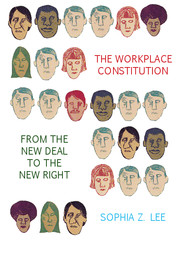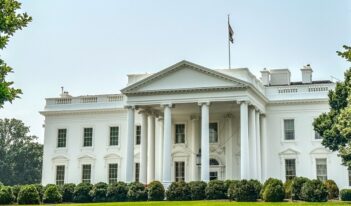
Agencies are deeply enmeshed in creating our constitutional understanding.
Sophia Lee’s The Workplace Constitution: From the New Deal to the New Right offers a remarkable window on the federal administrative state. Focusing on the National Labor Relations Board (NLRB) and implementation of federal labor statutes, she traces the development of administrative civil rights and labor rights strategies from the early years of the New Deal through to the 1980s.
Lee demonstrates how the idea of a workplace constitution — “that workers had constitutional rights on the job and in the union” — developed over time. This idea had a dual status: it served both as a means of defending African-American workers against the combined onslaught of discriminatory employers and segregated white unions, and as a tool for advancing anti-union and right-to-work interests. Lee brilliantly portrays the ways that liberal and conservative arguments for the workplace constitution played off of one another, while never losing sight of the wider political context in which these analytic battles were worked out.
Lee’s book is more than just a first-rate historical account of the intersecting development of American civil and labor rights in the twentieth century. It is also a significant contribution to the study of constitutional implementation and development — in this case, by federal administrative agencies. Lee describes how officials at the NLRB, Department of Justice, and other agencies grappled with a core constitutional question: to what extent did the Constitution require a government agency to act against discrimination by the private entities and organizations it regulates. Lee does an exceptional job of bringing to life this constitutional debate, one that was a recurring theme underlying efforts by officials and advocates to prod regulatory agencies into greater civil rights enforcement.
Of particular value is Lee’s depiction of how constitutional questions in the administrative realm are inseparable from debates over policy and the scope of an agency’s statutory authority. In the case of the NLRB, for example, arguments that the Board was constitutionally bound to deny certification to discriminatory unions were overcome by concerns that denying certification on this basis would violate the National Labor Relations Act (NLRA) and would unfairly work to the benefit of antiunion and discriminatory employers.
 The Workplace Constitution is thus a major contribution to the literature on administrative constitutionalism. Although largely historical and descriptive, it provides a strong foundation for thinking more theoretically and normatively about the role administrative agencies can and should play in constitutional development. As Lee recounts, the chair of the NLRB argued that as an administrative agency, the NLRB was precluded from finding that the Constitution trumped the NLRA. Therefore, as the NLRA instructed the Board to certify a union having majority support, the NLRB lacked authority to deny certification to discriminatory unions. Countering the chair’s position, a dissenting NLRB member insisted that the Board was bound to apply the NLRA with an eye to avoiding constitutional violations and that statutes are implicitly subject to statutory constraints. These two positions nicely showcase a central normative debate of administrative constitutionalism: when, if ever, is it legitimate for an agency to deviate from governing statutory commands out of constitutional concerns, particularly constitutional concerns that have yet to receive judicial sanction?
The Workplace Constitution is thus a major contribution to the literature on administrative constitutionalism. Although largely historical and descriptive, it provides a strong foundation for thinking more theoretically and normatively about the role administrative agencies can and should play in constitutional development. As Lee recounts, the chair of the NLRB argued that as an administrative agency, the NLRB was precluded from finding that the Constitution trumped the NLRA. Therefore, as the NLRA instructed the Board to certify a union having majority support, the NLRB lacked authority to deny certification to discriminatory unions. Countering the chair’s position, a dissenting NLRB member insisted that the Board was bound to apply the NLRA with an eye to avoiding constitutional violations and that statutes are implicitly subject to statutory constraints. These two positions nicely showcase a central normative debate of administrative constitutionalism: when, if ever, is it legitimate for an agency to deviate from governing statutory commands out of constitutional concerns, particularly constitutional concerns that have yet to receive judicial sanction?
The legitimacy of presidential constitutionalism is frequently debated, most recently in the context of President Obama’s refusal to defend the constitutionality of the Defense of Marriage Act in United States v. Windsor. By contrast, until recently, constitutionalism by administrative agencies garnered little attention. Indeed, in 2009 the Supreme Court dismissed the suggestion that an agency might be required to take constitutional concerns into account to ensure its decision was not arbitrary and capricious. This lack of interest in administrative constitutionalism is of a piece with the Court’s move towards greater judicial constitutional supremacy—again, well-captured by Windsor’s reference to the Court’s “primary responsibility” for determining a law’s constitutionality. It also may reflect background unease with the thought of an agency turning constitutional tables on Congress and holding a statute unconstitutional. Better, on this view, to keep agencies out of the business of independent constitutional interpretation altogether.
Yet administrative constitutionalism is unavoidable. In the modern administrative state, where agencies are the primary policymakers and law-implementers, agencies necessarily play a primary constitutional role. As Lee’s The Workplace Constitution shows us, agencies are deeply enmeshed in creating the constitutional understandings that govern our age. Rather than ignoring this phenomenon or relegating it to the outskirts of constitutional law, we should bring it front and center as Lee has done.
This essay is part of a six-part series, The Struggle Over the Constitution in the Workplace.




